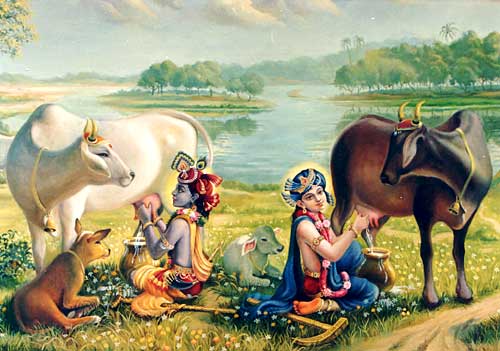If one is truly serious about achieving the ultimate goal of human life by perfecting his spiritual inquiry, he must adopt a life style that is conducive to the cultivation of self-realizing knowledge. This life style can be beautifully summarized in the phrase ‘simple living and high thinking’. Here simple living is in relation to maintenance of the body, and high thinking is in relation to the aim of one’s intellectual pursuits.
In order to exist in this world it is necessary to maintain one’s bodily existence, but as will be shown later, maintenance of the body is not progress towards the goal of life. Maintenance just allows one to perform the activity of existing in a particular body, which does not denote any accomplishment of a goal. This maintenance of the body involving mainly our activities of eating, sleeping, mating and defending is not in itself any great feat or achievement. Even the animals are engaging in these activities of bodily maintenance. The cows also eat, the birds also mate, the hogs also sleep and the dogs also defend. Simply engaging in these activities of maintenance does not actually make one human. For this reason, one who is interested in achieving the real, permanent goal of life does not focus solely on these activities of bodily maintenance, but he rather focuses primarily on the path of perfection. This is why he adopts the process of simple living.
The basic principle of simple living is accepting whatever is necessary for maintaining the body, so that we can use the energized body for higher philosophical pursuits directed towards our pure self identity. One only accepts that which is necessary for existence and does not take anything that is an unnecessary complication to life. In this way, by the process of living simply, one will be able to, if properly directed, arrive at the point of ‘high thinking’, the actual human essence.
What exactly is the meaning of ‘high thinking’? High thinking entails the comprehension of the self as distinct from the temporary material body. Why should such an understanding be considered high? The first reason is because it is the factual reality of existence. Secondly, one’s vision is not focused simply on the low activities of bodily maintenance but on the higher realm of the eternal self. The soul is the actual energy source of the entire body. The soul is constitutionally superior to the dull, unconscious matter. Thus, the understanding of the superior energy, the conscious soul, is higher than the understanding of the inferior energy, the unconscious matter.
This body that we generally identify with is exactly like a vehicle being driven by a conscious driver. A car by itself is nothing but dead matter, but when a driver operates the vehicle, it appears to produce life symptoms (movement, production of by-products, signs of intellectual control, etc.) In the same manner, when the conscious soul makes contact with the material vehicle known as the body, the body appears to be possessing life. Factually, it is the soul within the body that is producing the life-symptoms. In the Gita this is stated as follows:
yatha prakashayaty ekah
kritsnam lokam imam ravih
kshetram kshetri tatha kritsnam
prakashayati bharata
“Just as the sun alone illuminates the universe, so does the living entity, one within the body, illuminate the entire body by consciousness.”
As the sun is present everywhere in the form of its energy, light, in the same way, the soul is experienced throughout the entire body in the form of its energy, consciousness. Thus consciousness is the symptom of the soul.
This consciousness is the eternal companion of the soul. As one cannot separate heat from fire, one also cannot separate consciousness from the soul. The soul, along with its consciousness, is eternal. They do not cease to exist even after the body has come to an end.
At this point one may wonder, “What happens to the soul when the body is finished?”
As a person puts on new garments, giving up old and useless ones, the soul similarly accepts new material bodies, giving up old and useless ones. Throughout one’s life the body is slowly but surely deteriorating, coming closer and closer to its end. When that body is no longer able to accommodate the soul, the nature provides the soul with another suitable body according to his previous actions. As the embodied soul continuously passes in this body from boyhood to youth to old age, the soul similarly passes into another body at the time of death. One who understands this fundamental truth of the self – that the eternal soul is separate and distinct from the temporary material body – becomes a self-realized soul. This stage of self-realization is the culmination of the process of high thinking backed by a dedicated life style of simple living directed towards the aim of life.













Namaskar
just thanking you for all the wonderful articles that bring warmth to my heart. I love the elderly ( in body) Babas so precious
Very good